Aylsham, Norfolk
Up to 1834
A parliamentary report of 1777 recorded Aylsham as having a workhouse for up to 80 inmates. The workhouse was built in 1776 in the angle between Commercial Road (now Bure Way) and New Road.
In 1805, prison reformer James Neild was much impressed by what he found at Aylsham, recording that:
The building was, however, demolished in 1842.
According to White's Directory of 1836, Foulsham had a workhouse which was "built on the waste in 1782, will accommodate 45, but seldom has more than 20 inmates."
In 1792, ten years after the passing of Gilbert's Act, the Oulton Gilbert Union of six parishes (Banningham, Blickling, Colby, Erpingham, Itteringham, and Oulton) was formed. Its workhouse at Oulton, three-and-a-half miles to the north-west of Aylsham, was leased from Lady Sheffield and was originally a farmhouse and stood about a mile to the south-east of Oulton church, was converted from an old farmhouse at a cost of £1,100. Erpingham joined the union in 1806, Coleby in 1811, and Itteringham and Banningham in 1832, when the workhouse was enlarged at a cost of around £300 to hold up to 80 paupers.
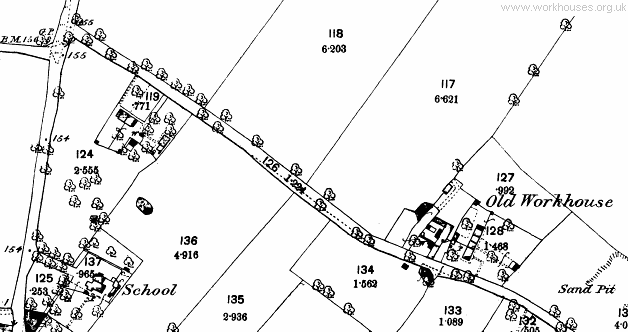
Oulton workhouse site, 1886.
In 1801, the Buxton Gilbert Union of three parishes was set up. In 1806, because of certain restrictions in the Gilbert Act, a Buxton Incorporation of nine parishes (Brampton, Burgh St Mary, Buxton, Hevingham, Marsham, Oxnead, Skeyton, Stratton-Strawless, and Swanton-Abbot) was formed under a local act. Buxton, four miles to the south-east of Aylsham, had a workhouse in a building dating from before 1800. The building was located at the east side of Coltishall Road, about half a mile to the south-east of Buxton.
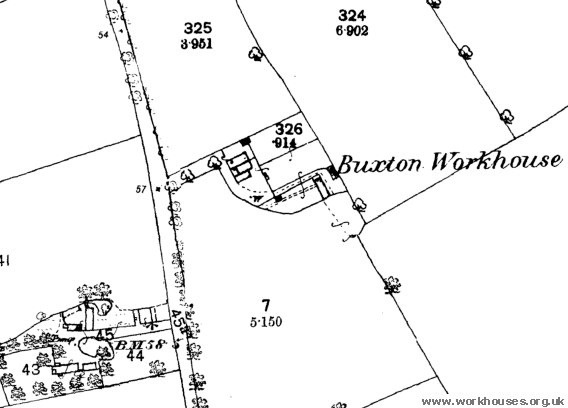
Buxton workhouse site, 1885.
Reepham had a workhouse which was also used by the parishes of Kerdiston, Hackford and Whitwell.
After 1834
In the spring of 1836, the Oulton Gilbert Union was dissolved. Aylsham Poor Law Union was formed on 9th April 1836. Its operation was overseen by an elected Board of Guardians, 47 in number, representing its 46 constituent parishes as listed below (figures in brackets indicate numbers of Guardians if more than one):
Norfolk: Alby, Aylsham (2), Barningham, Belaugh, Blickling, Brampton, Burgh, Buxton, Calthorpe, Cawston, Colby, Coltishall, Corpusty, Erpingham, Foulsham, Great Hautbois, Guestwick, Hackford, Hevingham, Heydon, Hindolvestone, Ingworth, Irmingland, Itteringham, Lammas with Little Hautbois, Little Barningham, Mannington, Marsham, Oulton, Oxnead, Reepham with Kerdiston, Sall, Saxthorpe, Scottow, Skeyton, Stratton Strawless, Swanton Abbott, Themelthorpe, Thurning, Thwaite, Tuttington, Whitwell, Wickmere, Wolterton, Wood Dalling, Wood Norton.
The population falling within the Union at the 1831 census had been 19,351 — ranging from Irmingland (population 16) to Aylsham itself (2,334). The average annual poor-rate expenditure for the period 1833-35 had been £20,391 or 21s.1d. per head.
The new Aylsham Union initially carried on using the Aylsham parish workhouse, together with the workhouses at Buxton and Oulton which were adapted and enlarged in 1836 at a cost of around £1200. On 17th May 1836, a letter to the Poor Law Commissioners from Dr J P Kay (PRO MH12/8185) records:
...
2. Oulton Workhouse. That no persons be received into this workhouse for more than one night, excepting ablebodied single men, and ablebodied single women, but that ablebodied married paupers and their children passing from the most distant parishes in the Eynsford district for the union, to the Buxton workhouse, may, if so ordered by the Board of Guardians, be lodged for one night in the probationary wards of this House on their way to the Buxton Workhouse, but for one night in each case only, and never unless ordered by the Board of Guardians.
However, White's Directory of 1845 records of Aylsham Union:
In 1848-9, a new workhouse for up to 600 inmates was built at Aylsham, situated to the west of the town. It cost approximately £7,500 and was designed by William J Donthorn who was the architect of other Norfolk workhouses at Downham, Erpingham, Freebridge Lynn, and Swaffham. Aylsham's broadly cruciform layout can be seen on the 1906 OS map, which also shows a later hospital to the north-east.
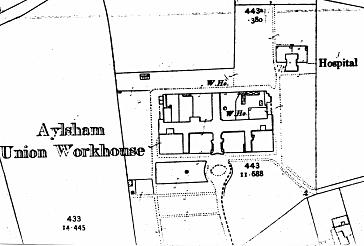
Aylsham workhouse site, 1906.
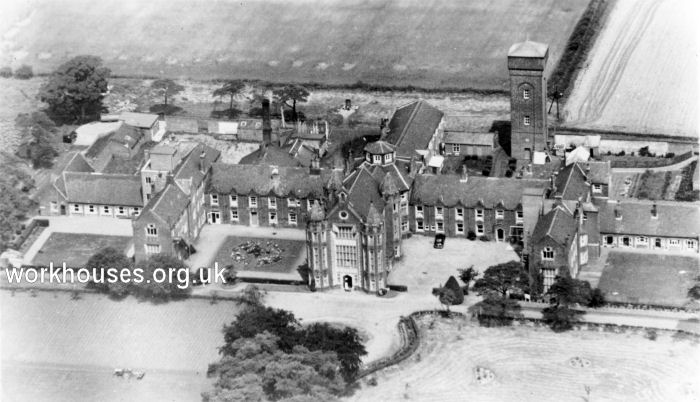
Aylsham workhouse site, aerial view from the south-east.
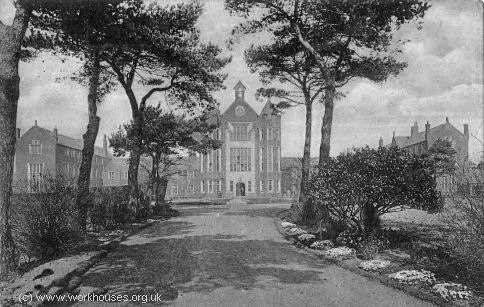
Aylsham workhouse, c.1910.
© Peter Higginbotham.
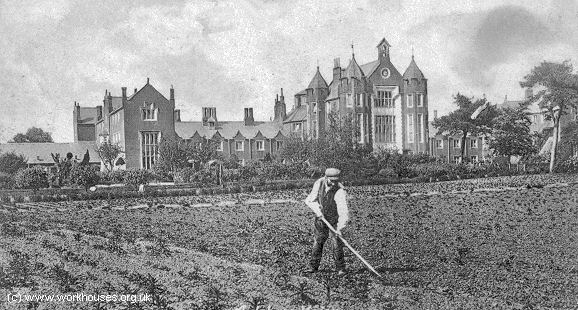
Aylsham from the south-west, c.1910.
© Peter Higginbotham.
The three-storey central wing to the south has an impressive facade of mullioned windows.
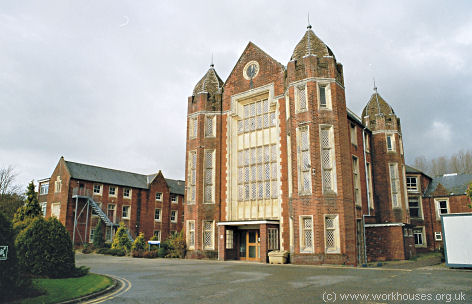
Aylsham from the south-east, 2005.
© Peter Higginbotham.
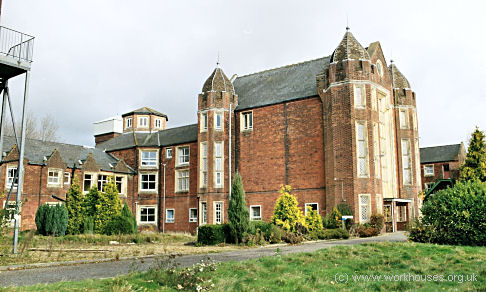
Aylsham from the south-west, 2005.
© Peter Higginbotham.
The south wing has a number of turrets containing staircases.
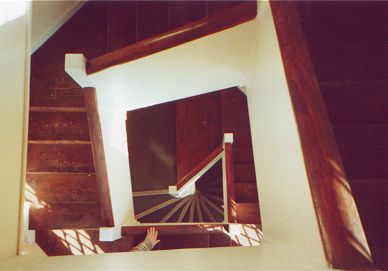
Aylsham staircase, 2000.
© Peter Higginbotham.
On the first floor of the south wing was located the Guardian's board-room.
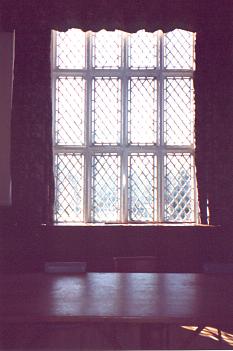
Aylsham Board Room, 2000.
© Peter Higginbotham.
The main two-storey range is built around an octagonal hub.
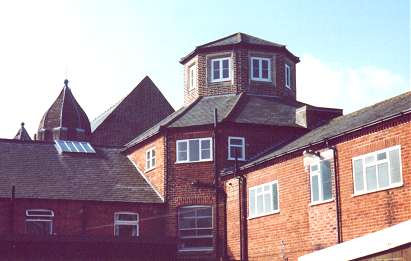
Aylsham from north-east, 2000.
© Peter Higginbotham.
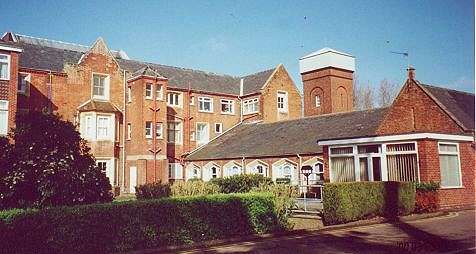
Aylsham from east, 2000.
© Peter Higginbotham.
In 1894, the British Medical Journal set up a "commission" to investigate conditions in provincial workhouses and their infirmaries. Following a visit to Aylsham, the commission's report had relatively few complaints about conditions in the institution, apart from some fairly modest improvements that were required in the lying-in ward and children's nursery. Further details are available in the full report.
A 1923 view shows an Artesian well being dug at the rear of the workhouse by the firm of FH Buckingham of Hethersett.
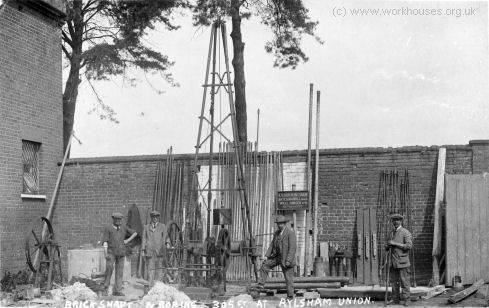
Aylsham workhouse, c.1923.
© Peter Higginbotham.
The workhouse was redesignated as a Public Assistance Institution in 1930, then becoming St Michael's Hospital, latterly specialising in geriatric care. In 2011, after lying empty for a number of years, the main workhouse building was converted to residential use.
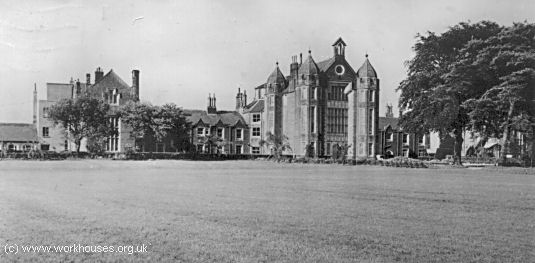
Aylsham from the south, 1960s.
© Peter Higginbotham.
Staff
- 1844 - Buxton workhouse master: Thomas Potter; Oulton workhouse master: EF Barnaby.
- 1881 Census
Inmates
Records
Note: many repositories impose a closure period of up to 100 years for records identifying individuals. Before travelling a long distance, always check that the records you want to consult will be available.
- Norfolk Record Office, The Archive Centre, Martineau Lane, Norwich NR1 2DQ. Holdings include: Guardians' minute books (1836-1930); Births (1849-1944); Deaths (1849-91, 1914-40); Burials (1857-1903); Casuals (1879-1931); etc.
Bibliography
- Digby, Anne. Pauper Palaces (1978, Routledge & Kegan Paul)
- Crowley, J & Reid A. The Poor Law in Norfolk, 1700-1850 (1983, EARO)
Links
Unless otherwise indicated, this page () is copyright Peter Higginbotham. Contents may not be reproduced without permission.


